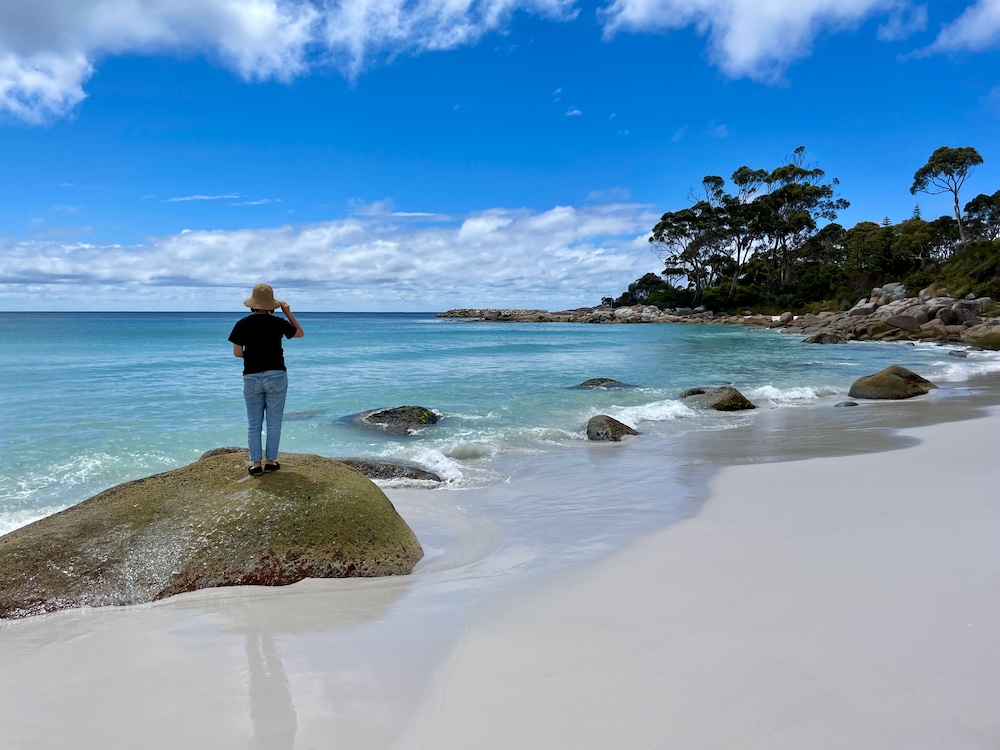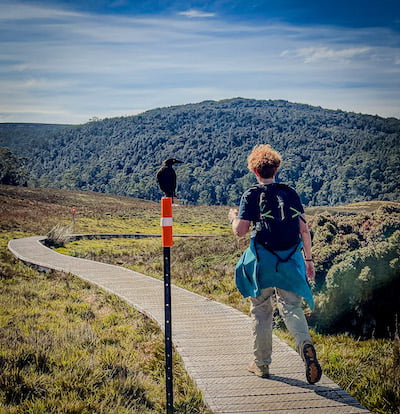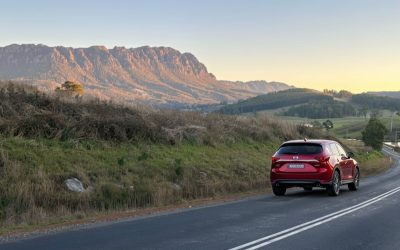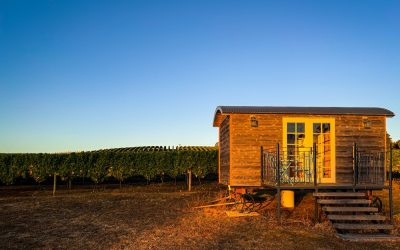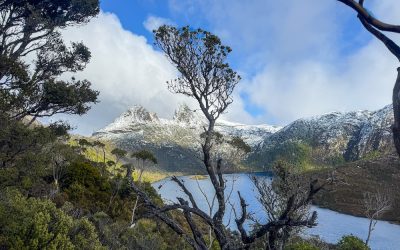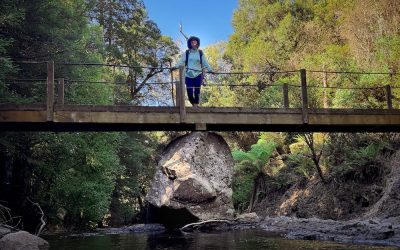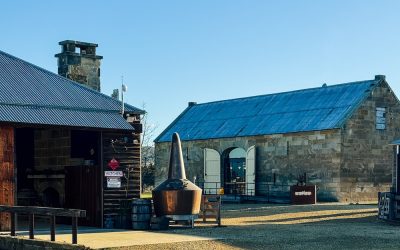The beaches in Tasmania are nothing short of dazzling. White sand so fine it squeaks and water that shifts from turquoise to deep sapphire. Some beaches feel untouched. Deserted. Others buzz with the rhythm of small holiday towns where you can swim, eat and linger into the evening. In this guide I’ve listed the 12 best beaches in Tasmania. You’ll find iconic spots that make the usual top 10 lists. But also wild remote surprises. A couple of beaches on this list are even dog-friendly, because our boys love the beach. I’ll also cover nearby stays or cafés that turn some of these classic beaches in Tasmania into much more than an afternoon stroll.
(Use the interactive Beaches in Tasmania map at the end 👇🏽 to plan your travel route.)
Iconic Beaches in Tasmania you just can’t miss
1. Binalong Bay Beach
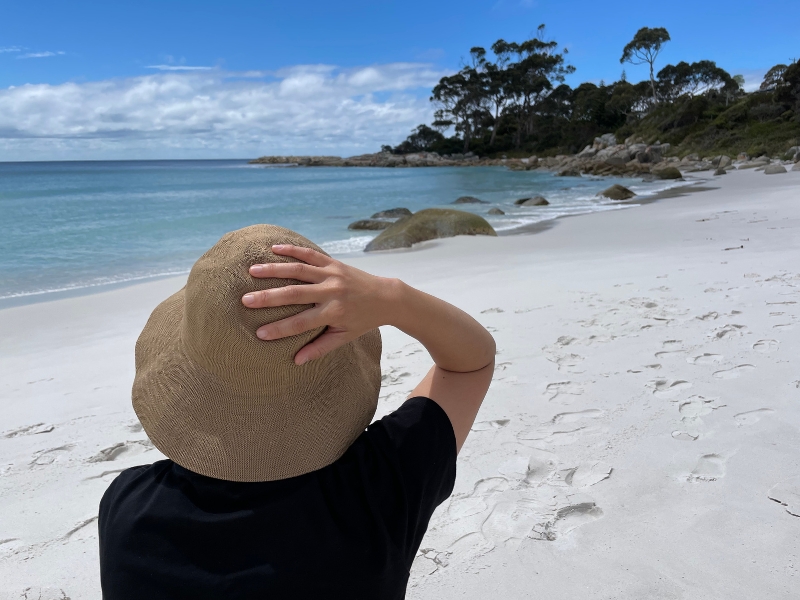
Binalong Bay is the jewel of the Bay of Fires and, in my book, the best beach in Tasmania. White sand so fine it squeaks. Water that glows in shades of turquoise and blue. Granite boulders brushed with bright orange lichen. The colours are so vivid they almost look unreal.
The bay itself is usually calm, which makes it perfect for a swim or a long paddle in the shallows. It’s also one of the most photogenic stretches of coast you’ll find anywhere in Australia. If you’re chasing the postcard shot of Tasmania’s beaches, this is it.
Before or after your beach time, stop at The Hub Café right in Binalong Bay. It’s the sort of place where you can linger over good coffee, brunch, or even a late lunch, all with that big ocean view at your elbow.
To really soak it in, base yourself here for a night or two. That way you can enjoy the softer light at sunrise and sunset, when the crowds are gone and the beach feels like it’s yours alone. I’ve put together a full Bay of Fires Accommodation Guide with the best places to stay nearby, from seaside cottages to luxury eco-lodges. It’s worth it to make the most of Tasmania’s number one beach.
Pair it with:
- A walk or drive further north to Swimcart, Jeanneret, and the quieter coves of the Bay of Fires.
- Snorkelling in the bay when the water is calm.
- An evening picnic of local Lease 55 Oysters (between St Helens and Bay of Fires) on the sand, with that view front and centre.
- A self-guided Bay of Fires walk with just you, your backpack and a string of amazing beaches to explore.
2. Swimcart Beach, Bay of Fires
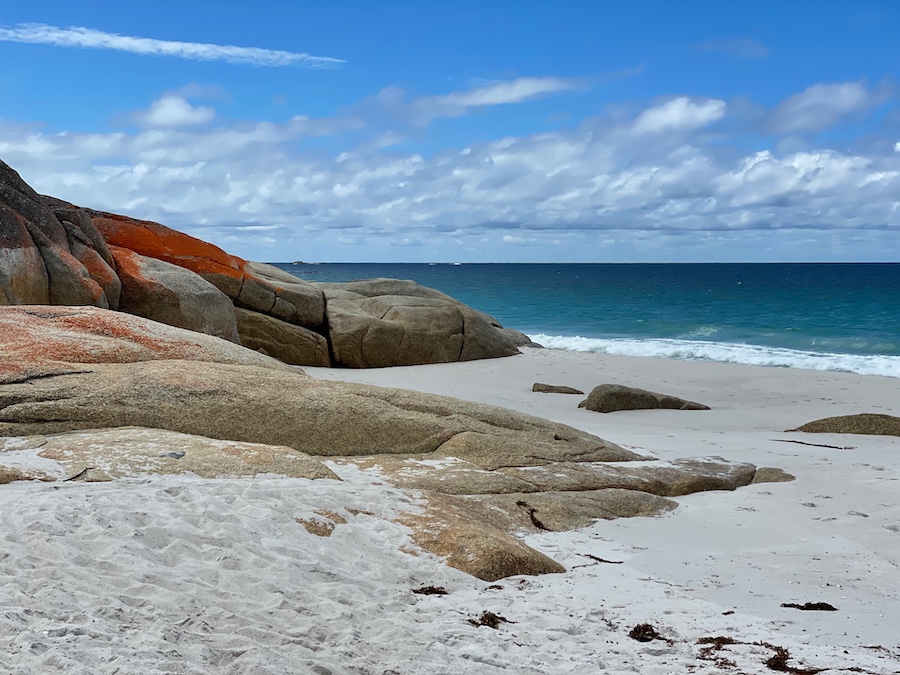
Swimcart is one of the most photographed beaches in the Bay of Fires, and it lives up to the hype. The sand is blindingly white, the water a shifting mix of blue and green, and the granite boulders are painted with that signature orange lichen. It’s a landscape of contrasts, and when the afternoon light drops across the bay the colours seem to glow. If you’re looking for the best Tasmanian beaches, this one packs a punch.
What sets Swimcart apart is the chance to camp right next to the sand. The campground here is free, first-come, first-served, and sits just behind the dunes. You wake up to the sound of waves, step outside your tent or camper, and the beach is at your feet. There are no facilities apart from basic toilets, so bring your own water and supplies. In summer it fills quickly, so arrive early in the day if you’re hoping to snag a spot.
The beach itself is long and wild. On calm days you can paddle in the shallows, but more often it’s about walking, photographing the colours, or watching the surf pound in. Sunrise is a favourite time — the sky catches fire, and the whole place feels untouched.
Where to stay: If camping isn’t your style, nearby Binalong Bay and St Helens has plenty of accommodation, from simple motels to waterfront apartments. Our favourite stay close to Swimcart Beach is Bay of Fires Bush Retreat – it’s glamping like you’ve never experienced.
Pair it with:
- A drive north along Gardens Road to explore the Gardens.
- An evening meal of fish and chips in St Helens, Tasmania’s unofficial seafood capital.
- Sunrise or sunset photography right on the sand.
Good to know:
- No drinking water on-site — bring what you need. There are toilets, but they’re the drop kind of variety.
- The access road is unsealed and can be bumpy, but manageable in a standard car with good road clearance.
3. Wineglass Bay Beach, Freycinet Peninsula
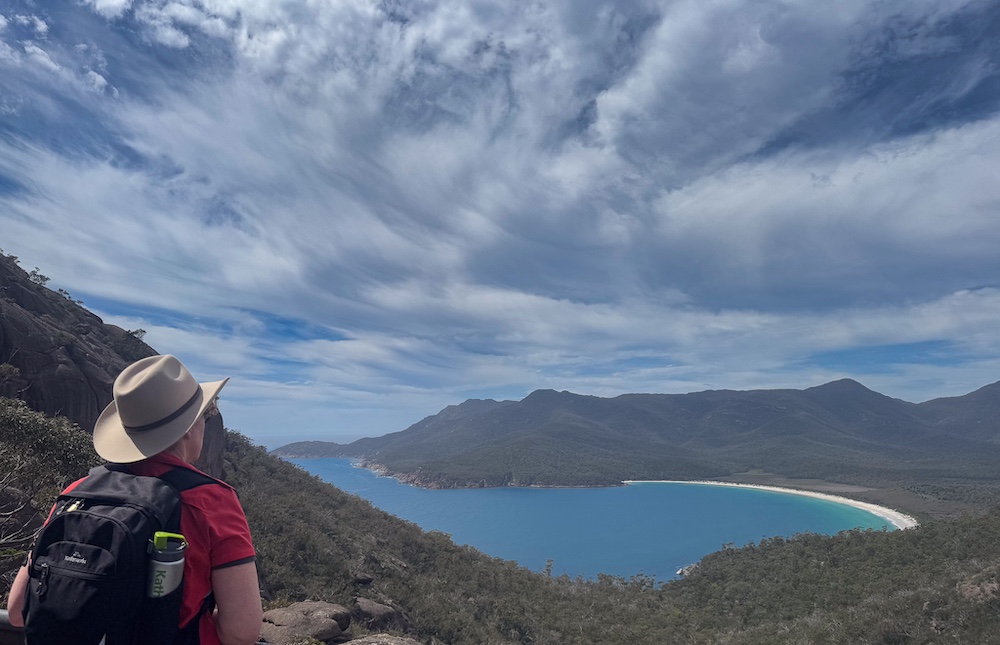
Wineglass Bay is a rare kind of iconic Tasmanian beach — the shape of the curve, the white sand pressed between mountain slopes, the water shifting from pale turquoise near shore to deeper sapphire further out. It’s the image you’ve seen a thousand times — and when you see it in person, it still takes your breath.
Getting down to the beach means earning it. You’ll walk the trail from Coles Bay up to the lookout first — a moderate climb of about 1.3 km each way — then descend the natural steps and paths toward the sand. The lookout is your reward: that perfect bow-shaped bay with granite peaks (the Hazards) guarding it.
On calmer days, the water near the shore is inviting. But because the bay opens out to the ocean, you need to pick your time — mornings or late afternoon tend to be safer. Once you’re there, the sand is soft, the bay expansive, and the view compelling enough to make you linger beyond what you planned.
Where to stay: Coles Bay is your gateway. We love Freycinet Lodge for a luxe cabin stay in this area. The restaurant and bar onsite are irresistible for sunset cocktails overlooking Coles Bay.
Pair it with:
- Hiking the Wineglass Bay & Hazards Beach circuit (approx. 11 km) .
- A climb of Mount Amos for dramatic views over the bay and peninsula.
Good to know:
- The trip down to the beach is via a steep descent; it’s manageable but takes care and good knees.
- No facilities on the bay itself — carry water, snacks, and sunscreen.
- Be ready early if you want the best light and fewer people at the lookout.
- Park entry and passes are required for Freycinet National Park.
4. The Neck, Bruny Island
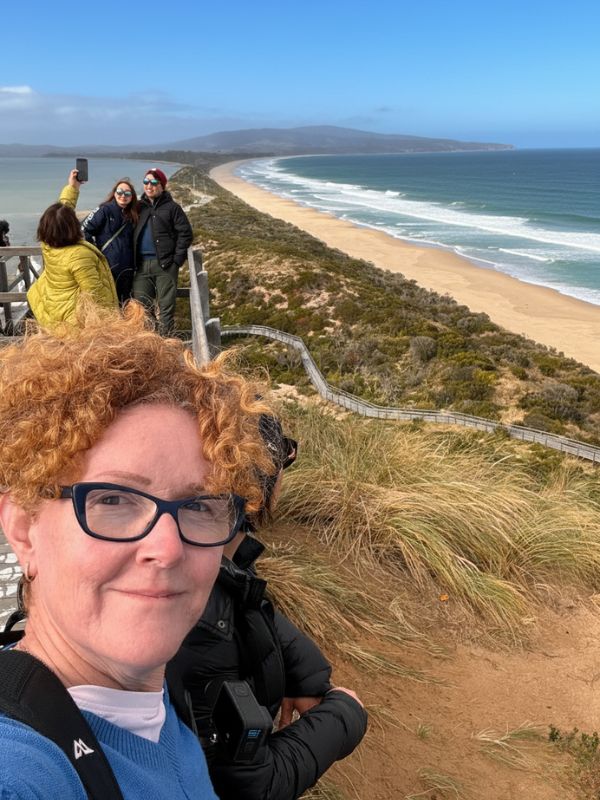
The Neck is one of Tasmania’s most photographed landscapes. A slender strip of sand connects North and South Bruny, with ocean on one side, the D’Entrecasteaux Channel on the other, and a timber staircase leading to the lookout above. The view from the top is breathtaking — sweeping arcs of beach stretching in both directions, with forested hills rolling away in the distance.
Climb the 200-plus steps to Truganini Lookout for the full beach panorama. It’s best in the early morning when the light is soft, or at sunset when the colours fire up the sky.
On the beach below you can wander for kilometres in near solitude, waves pounding. This is one sweeping, wild, and unforgettable beach. So take extra care if you do swim here.
The Neck is also home to a colony of little penguins. At dusk they return from the ocean and waddle up the beach to their burrows. Viewing platforms make it easy to watch without disturbing them, and seeing them in the wild is a highlight for many visitors.
Where to stay: Most people visit The Neck as part of a day trip, but you’ll find cabins and campsites scattered across Bruny. Staying near Adventure Bay or Alonnah puts you within easy reach.
Pair it with:
- A seafood stop at Get Shucked Oysters or a tasting at Bruny Island Cheese Co. on the drive south.
Good to know:
- The staircase is steep but manageable; wear good shoes if it’s wet.
- Parking is available at the base of the lookout, but it fills quickly in peak summer.
- Dogs are not allowed due to penguin colonies.
5. Adventure Bay Beach, Bruny Island
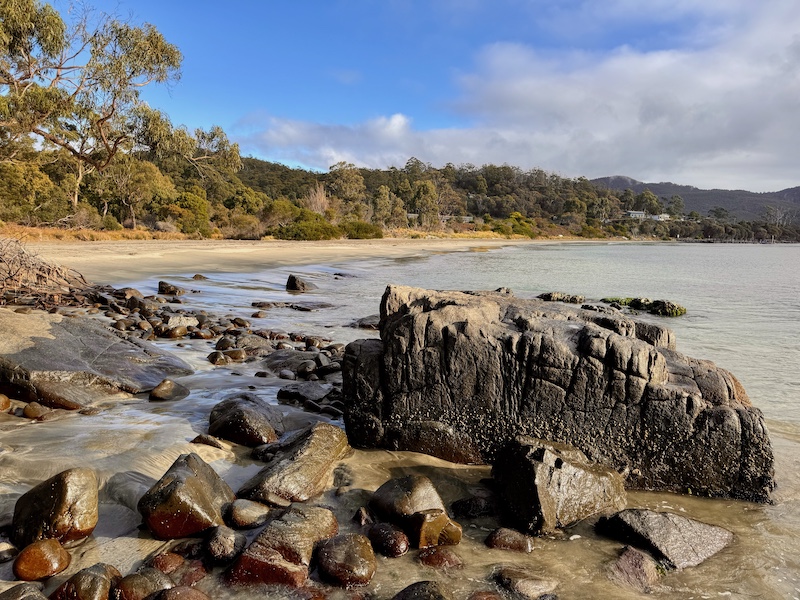
Adventure Bay is the heart of Bruny Island’s east coast and one of its most beautiful beaches. The bay is long and sheltered, with calm turquoise water that laps against soft white sand. Forested headlands frame the shoreline, and in summer the beach has a gentle hum of families swimming, picnicking, and paddling in kayaks.
What makes Adventure Bay special is the wildlife. This is one of the few places in Tasmania where you can spot white wallabies, a rare genetic variation of the Bennett’s wallaby. They often appear around dusk on the grassy edges behind the beach. Even if you miss them, you’ll likely see plenty of roos and birdlife during the day.
The beach is also the starting point for two of Bruny’s best short walks. The Grass Point Track is a gentle foreshore trail that winds past rocky coves and forest before finishing at the site of an old whaling station. If you want something more dramatic, the Fluted Cape Track climbs high above the cliffs for sweeping views of the bay and beyond. Both walks begin at the southern end of the beach, so it’s easy to tie a swim, a walk, and a picnic together in one visit.
Where to stay: Adventure Bay Retreat is an incredible lodge stay walking distance to the beach.
Pair it with:
- A morning swim followed by the Grass Point or Fluted Cape walk.
- A wildlife-spotting evening looking for white wallabies.
- A visit to Bruny Island Cheese Co. or Get Shucked Oysters on your way back towards the ferry.
Good to know:
- The bay is usually calm and safe for swimming, but keep an eye on changing conditions.
- Basic facilities and picnic areas are available near the main access points.
- In peak summer, accommodation books out quickly, so plan ahead if you want to stay near the beach.
📕 Read More: Best Bruny Island Day Trip Itinerary
Holiday town beaches in Tasmania
6. Boat Harbour Beach

Boat Harbour feels like discovery. A sheltered cove on Tasmania’s north-west coast, it combines soft, squeaky sand and crystal-clear water with a backdrop of rugged cliffs and green hills. The place has calm energy — low crowd levels, a gentle rhythm, a feeling that you’re in on a secret.
The bay is usually calm enough for a swim, and on good days it invites paddleboarding or wading. The clarity of the water is impressive — you can see straight to the depth underfoot. If nothing else, it’s a beach where you can sit in silence, ears full of wind and waves, and just let the scenery do the work.
You can’t beat breakfast or lunch at Seekers Bar & Café, located right on the sand. It’s the only café in the bay, and it does more than coffee: seafood, fish and chips, a full midday menu. Order a seat outside so your toes nearly touch the edge of the beach. It turns a beach day into a full, slow coastal experience.
Where to stay:
Accommodation with direct access to the beach is limited but worthwhile. The Summer House and Seascape Beach House are excellent options. 17 Steps to the Beach is a standout beachfront house. If you want powered sites or cabins, the Boat Harbour Beach Holiday Park behind the beach has full amenities, cabins, powered and unpowered sites. Book early — there’s not much spare capacity in peak times.
Pair it with:
- A walk around the headland on the short Boat Harbour Beach Track loop, offering panoramas across Bass Strait and the bay.
- The more demanding Boat Harbour to Postman’s Track coastal route — do it at low tide for the beach sections.
- A road trip to Stanley and The Nut (30–40 minutes away), or a detour into Rocky Cape National Park and local walks inland.
- A visit to nearby Wynyard and Table Cape, especially when the tulip fields are in bloom.
Good to know:
- Parking & facilities: There’s a decent car park, public toilets, undercover BBQs, picnic benches, and a playground. The recreational area is for day use — camping on the beach isn’t allowed.
- Swimming & weather: The cove shelters the beach so conditions are not too rough, but Bass Strait temperatures stay cool — summer surface highs reach around 18–20°C.
- Dogs: Dogs are allowed in the recreation area and on parts of the beach, but must be kept on leash at all times.
📕 Read More: Unmissable Boat Harbour Beach Tasmania Guide
7. Kingston Beach
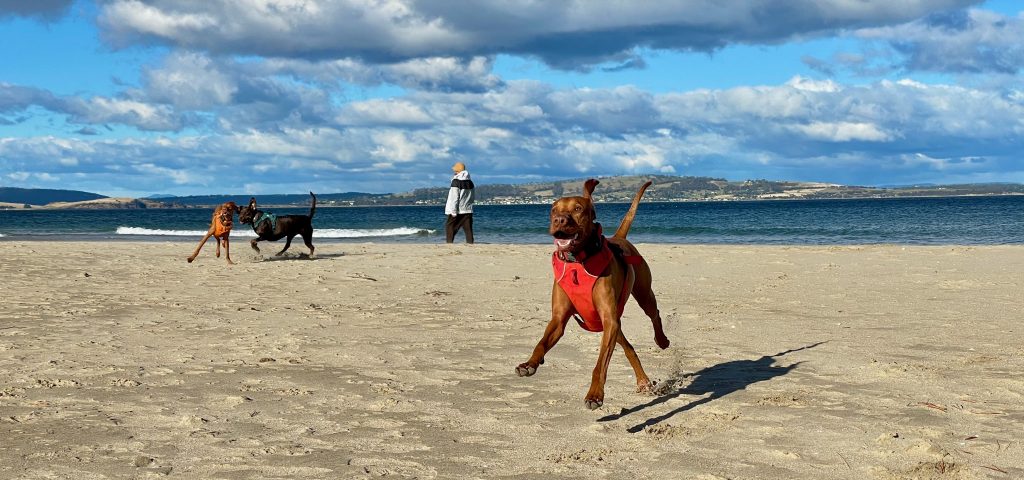
Kingston tops our list of beaches in Tasmania near Hobart. Just ten minutes south of the city, it’s a wide curve of golden sand with views out to the Derwent and Mount Wellington sitting behind. The beach has a buzz about it — families swimming, people strolling the esplanade, cafés spilling onto the street, and dogs chasing each other on the sand.
What makes Kingston stand out is how many ways you can use it. There’s a designated dog beach at the northern end, where pups run off-lead and splash in the shallows. The southern end is better for swimming, with surf lifesavers on patrol in summer. In between you’ll find walkers, kayakers, and locals making the most of the wide stretch of sand.
When you’re ready for a break, cross the road to the Salty Dog Hotel. It’s one of those classic seaside pubs that’s perfect for a sunny lunch or a late-afternoon drink in the beer garden. On weekends it hums with live music and conversation, which adds to the beach’s social feel.
Where to stay: Kingston itself has motels and self-contained apartments, but the bigger choice is in Hobart. Staying in the city gives you the flexibility to day trip south for the beach while keeping easy access to Hobart’s dining and attractions.
Pair it with:
- Lunch and a Sunday session at the Salty Dog Hotel.
- A drive south to explore Blackmans Bay or continue further to the Huon Valley.
Good to know:
- Parking can be tight on hot summer days — arrive early for a spot near the esplanade.
- Surf lifesavers patrol the southern end in summer.
- Dogs are welcome year-round at the northern end but check signage for leash rules.
- Facilities include toilets, playgrounds, BBQs, and shaded seating, which makes it one of the most family-friendly beaches near Hobart.
8. Tatlows Beach, Stanley
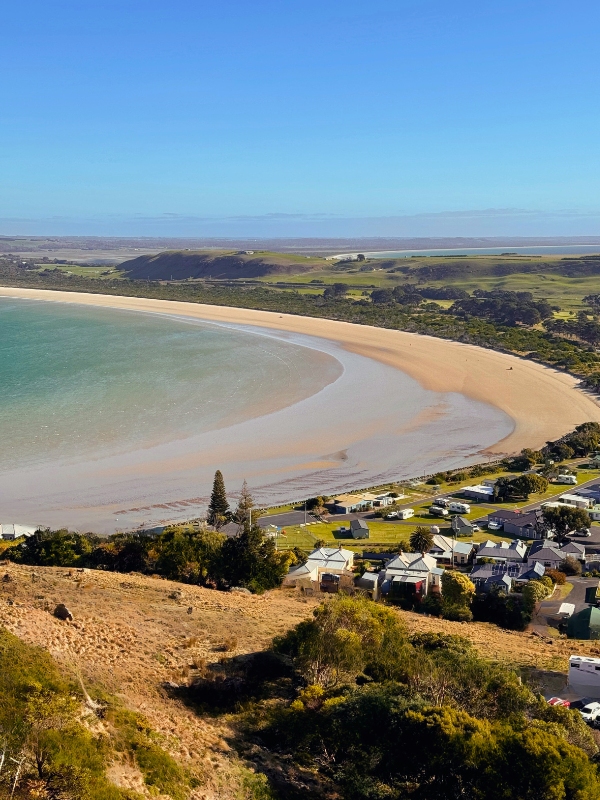
Tatlows Beach is the wide sandy sweep that greets you as you approach Stanley. The Nut rises at the far end like a sentinel, and behind the sand are some of the greenest paddocks you’ll see in Tasmania. The view is classic north-west coast: big skies, calm water, and a town perched on the edge of the sea.
The beach itself is long and easy to walk. Locals use it daily, but it never feels crowded. The water is usually gentle enough for paddling, and the outlook back towards Stanley and The Nut is one you’ll keep stopping to photograph.
The best way to enjoy Tatlows is in the late afternoon. The light softens, the sand glows golden, and the bay feels calm and expansive. Walk the shoreline, then wander into Stanley for dinner, or linger longer and watch the sun sink behind the headland.
Where to stay: Stanley has excellent accommodation options. Hanlon House offers heritage charm close to the beach, while The Bayview Guesthouse looks across Tatlows and Sawyer Bay from higher on the hillside. There are also B&Bs and self-contained cottages tucked into the town.
Pair it with:
- A morning climb up The Nut for sweeping views across Tatlows and the coast.
- A seafood dinner in Stanley, where menus are stacked with local catch.
- A wander about town to explore Stanley’s history and the childhood home of Australia’s 10th Prime Minister Joe Lyons.
Good to know:
- Parking is straightforward along the approach road.
- Swimming is possible in the sheltered bay, but conditions can shift — stick to the shallows if the wind picks up.
9. Wrinklers Beach, Scamander
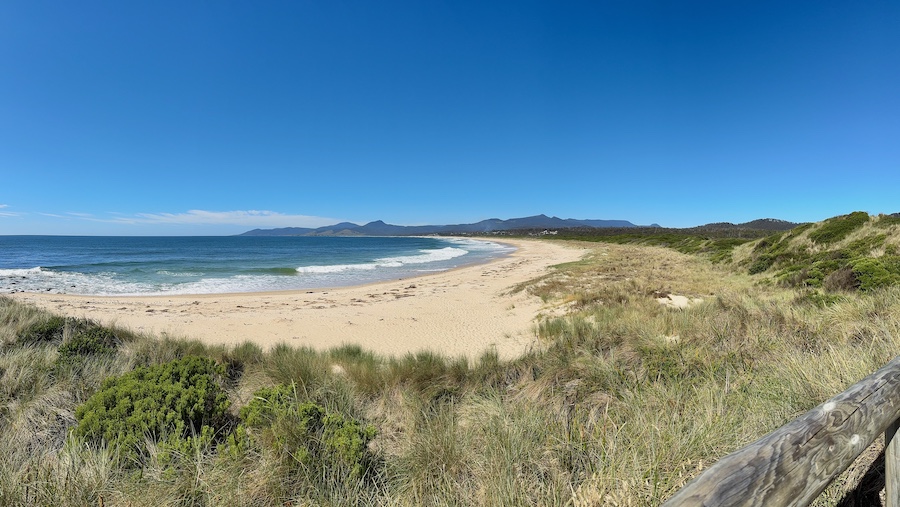
Wrinklers Beach is part of the long sandy sweep that runs along the coast at Scamander. It stretches for nearly two kilometres, backed by low dunes and the Tasman Highway, and has that classic east coast look — wide open sand, rolling surf, and a horizon that feels endless.
This is a local favourite more than a postcard icon. You’ll see people walking in the mornings, surfers checking the swell, and families finding a spot to picnic in summer. The beach has a relaxed, lived-in feel, and because it’s not as well known as Binalong Bay or Wineglass, it often feels like you’ve found your own patch of coast.
Swimming here is possible, but it’s usually more about strolling the sand and watching the surf. Scamander has strong currents and rips, so stick to shallow paddling unless you’re very confident in the water.
Where to stay: Scamander has caravan parks, motels, and beach houses that sit right across the road. For a bigger choice, Bicheno is half an hour south and makes a good base to explore this stretch of coast.
Pair it with:
- A morning walk followed by coffee in Scamander.
- An afternoon drive north to St Helens or south towards Bicheno.
- Watching the surfers tackle the break at the southern end of the beach.
Good to know:
- Parking is easy along the highway pull-ins. Just keep driving until you hit the beach path.
- It’s usually pretty deserted. Perfect for beach combing or a quiet stroll.
10. Coles Beach, Devonport
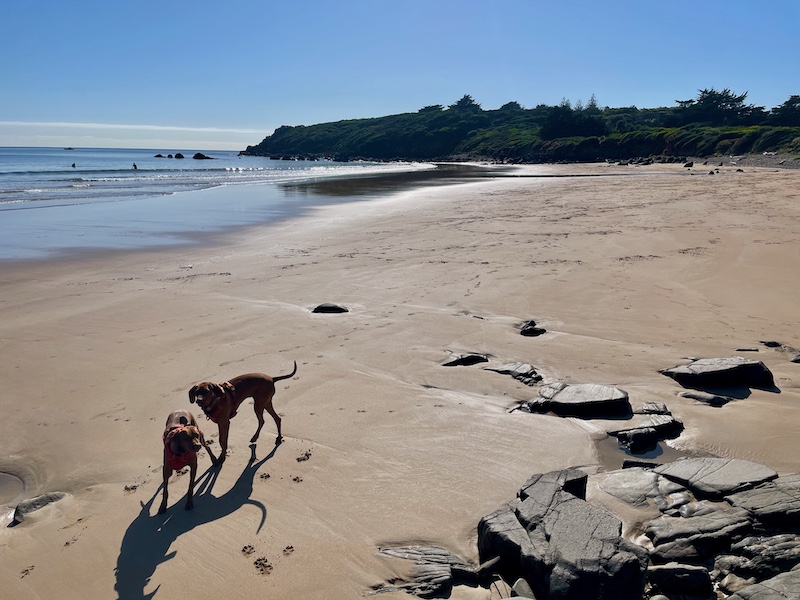
Coles Beach is an outlier on our list of top Tasmanian beaches. It’s a local favourite, and for good reason. It’s pretty, sheltered, with great soft sand, a cafe nearby, and dogs are welcome. And that unique mix is part of the charm. A pretty curve of pale sand, calm water in summer, and plenty of room for kids to splash while the dog runs the northern stretch. Locals walk it morning and evening. Visitors roll in for an easy swim and a soft place to spread a towel.
There are no facilities on the sand. You’ll find toilets, BBQs and picnic tables about 200 metres away at Mersey Bluff. That headland also gives you a short walk to the lighthouse and wide views along the coast.
Where to stay: Devonport has a good mix of Airbnbs, motels and apartments within a short drive. For the easy shortlist, jump to my Devonport accommodation guide and pick a base close to the foreshore.
Pair it with:
- A stroll to the Mersey Bluff Lighthouse and the foreshore reserve.
- Breakfast or coffee at Drift Café near Bluff Beach
Good to know:
- Calm, sheltered water makes it one of the north coast’s easier family swims in summer.
Wild & remote Tasmanian beaches
11. Friendly Beaches, Freycinet National Park
Friendly Beaches is a wild stretch of coast that feels endless and this is partly why it makes our list of best Tasmanian beaches. White sand runs for kilometres, the water shifts from pale turquoise to deep blue, and apart from the sound of the surf there’s often nothing else but silence. Step onto the boardwalk from the car park and it feels like you’ve walked into another world — raw, open, and spectacular.
The beach sits inside Freycinet National Park, so you’ll need a parks pass to visit. Once you’re in, it’s easy to lose track of time. Walk the shoreline, climb over the granite outcrops, or simply sit in the dunes and take in the scale of the place. It rarely feels crowded, even in peak season.
At the northern end you’ll find the Isaacs Point campground, which reopened in 2025 after a complete rebuild. It’s basic but unbeatable for location, with sites tucked just behind the dunes. Facilities are limited to toilets and shelters — bring your own water and supplies — but waking up to the sound of the waves makes it worth it.
Where to stay: If camping isn’t your style, Coles Bay has the full range of accommodation, from simple cabins to luxury lodges. Staying in town puts you close to both Friendly Beaches and the more famous Wineglass Bay walks.
Pair it with:
- A detour to Honeymoon Bay or the Cape Tourville walk.
- A day trip into Coles Bay for supplies and coffee.
- Sunset photography on the rocks when the sky turns pink and the water glows.
Good to know:
- The beach is exposed and conditions change quickly; swimming is only for strong, confident swimmers.
- Bring all your own supplies if camping — there’s no drinking water.
- Dogs are not allowed inside Freycinet National Park.
- Access is via an unsealed road, but it’s manageable in a standard car with decent clearance for the potholes.
Friendly beaches is not easy to find once you get off the highway, but Tasmania Parks and Wildlife do a good map of how to get to Friendly Beaches.
12. Jeanneret Beach, Bay of Fires
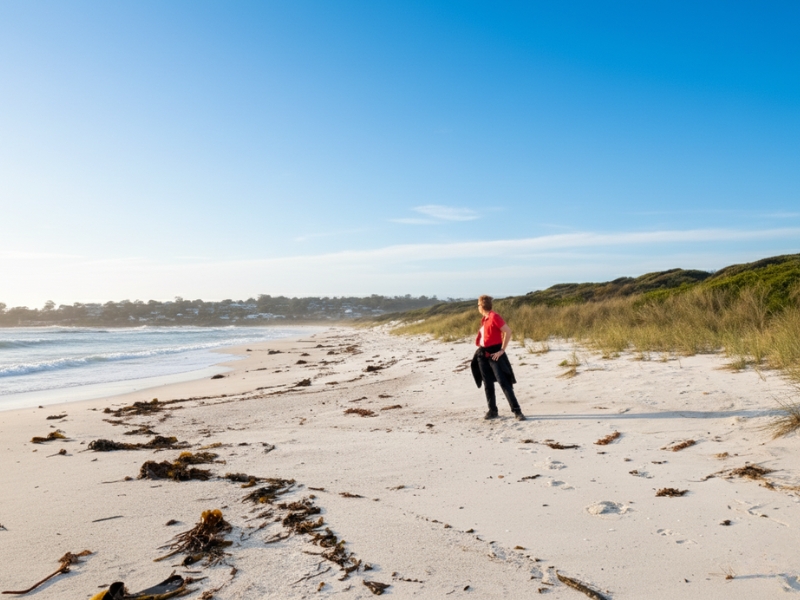
Jeanneret Beach is the quieter side of the Bay of Fires. A small cove framed by granite boulders and backed by low dunes, it has the same powdery white sand and bright aqua water as Binalong Bay, but with fewer people. On a calm day it feels like your own private bay.
The beach is great for swimming when conditions are gentle, though it’s more often about slow walks, picnics, and soaking up the view. The rocks at either end are brushed with the same orange lichen that makes this coast famous, and they glow even brighter at sunrise and sunset. If you’re chasing the Bay of Fires look without the crowds, this is where you’ll find it.
Where to stay: Binalong Bay is only a few minutes south and has holiday houses and cottages that make an easy base. St Helens, about 15 minutes away, has more accommodation, shops, cafes and supplies.
Pair it with:
- A morning coffee at The Hub Café in Binalong Bay before heading north.
- A boulder scramble and sunset photography with the orange rocks and rolling surf.
Good to know:
- Access is via a short unsealed road but manageable in most cars. Or you can walk around headlands from Binalong Bay Beach and access it from the sand.
- Watch for snakes in the riparian bushland alongside the beach. Deadly ones! Don’t be tempted to shortcut through the bush here in summer.
Beaches in Tasmania map
I’ve pinned all 12 best beaches in Tasmania onto the interactive map below so you can see how they line up around the island. It’s the easiest way to plan a road trip or work out which beaches fit into your itinerary.
Use the map to cluster your stays. The Bay of Fires beaches — Binalong Bay, Swimcart, and Jeanneret — all sit close together, so basing yourself in St Helens or Binalong Bay makes sense.
On the east coast, Friendly Beaches and Wineglass Bay pair naturally with a night or two in Coles Bay. For the north-west, Boat Harbour and Tatlows link well into a Stanley or Wynyard stay.
If you’re flying in or out of Hobart, it’s easy to tick off Kingston Beach, Adventure Bay, and The Neck on Bruny Island in a single trip south. And if you’re crossing on the Spirit of Tasmania, Coles Beach in Devonport is right on your doorstep the moment you arrive.
What’s Next
- Looking for a car to get you to these beaches? I’ve broken down everything in my Tasmania Car Rental Guide, including how to save money and what to watch for on the roads.
- Want to turn your beach stops into overnight stays? My Bay of Fires Accommodation Guide and Devonport Accommodation Guide will help you find the right base.
- Heading to Freycinet? Don’t miss my in-depth Freycinet National Park Guide, covering walks, stays, and how to make the most of Wineglass Bay.
- If you’re more of a day-trip traveller, check out my round-ups of the best day trips from Hobart and best day trips from Launceston.
FAQs
What is the best beach in Tasmania?
For sheer beauty, Binalong Bay Beach in the Bay of Fires is hard to beat. White sand, turquoise water, and orange granite boulders make it one of the most iconic beaches in the country.
Are Tasmania’s beaches safe for swimming?
Many are calm and family-friendly, like Coles Beach in Devonport or Kingston Beach near Hobart. Others, such as Friendly Beaches or Wrinklers Beach, are more exposed to strong rips and surf and are better for walking or photography. Patrolled beaches are not as common here as they are in Queensland and NSW. Unless you’re near Hobart. So always assess the conditions, know how to handle rips, and never swim alone.
Where can I camp by the beach in Tasmania?
The best-known beach adjacent camping of all the beaches on this list is at Swimcart Beach in the Bay of Fires. It’s free, first-come-first-served, and located right behind the dunes. Facilities are very basic, so bring water and supplies. Friendly Beaches also has a national park campground at Isaacs Point.
When is the best time to visit beaches in Tasmania?
Summer (December to March) is best for swimming and camping, with water temperatures around 18–20°C. Autumn and spring have fewer crowds and are perfect for long walks and photography. Winter brings moody skies and solitude, especially on Tasmania’s wild east and north-west coasts.
